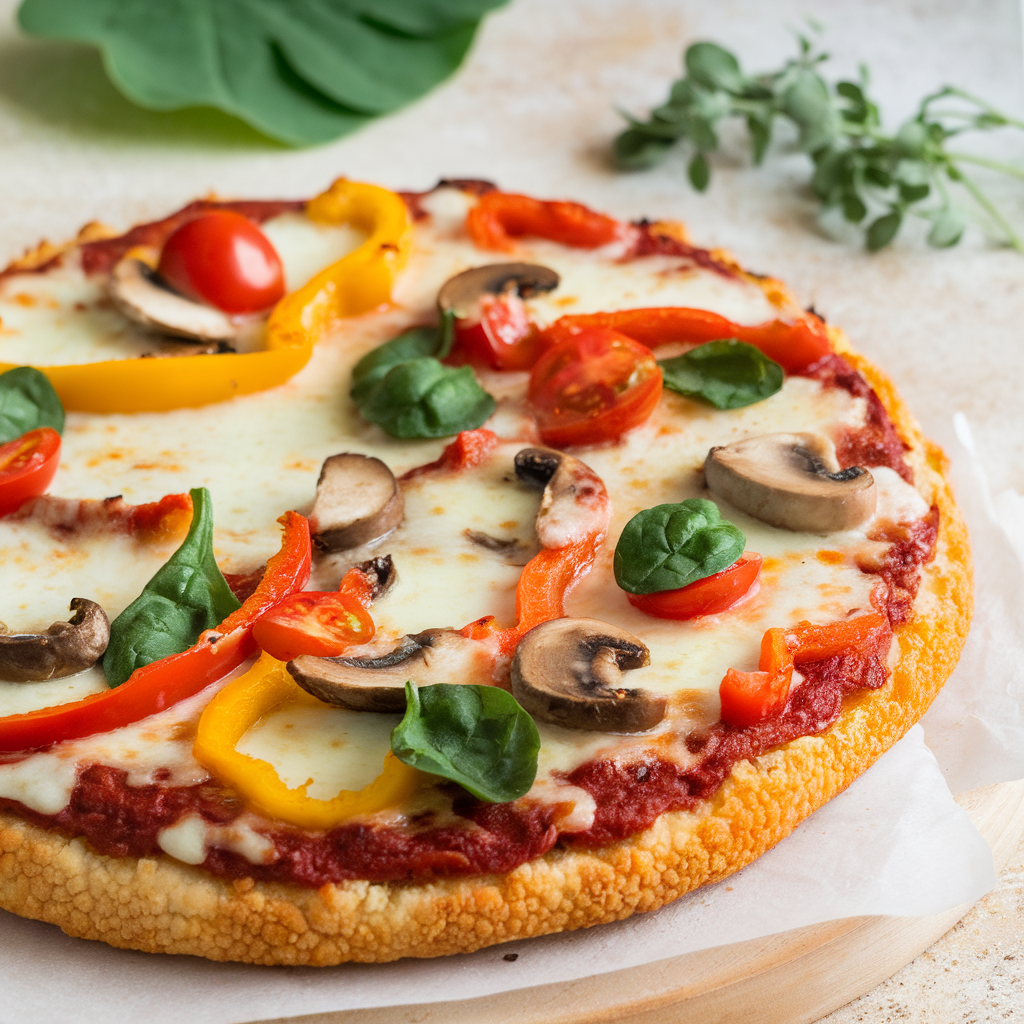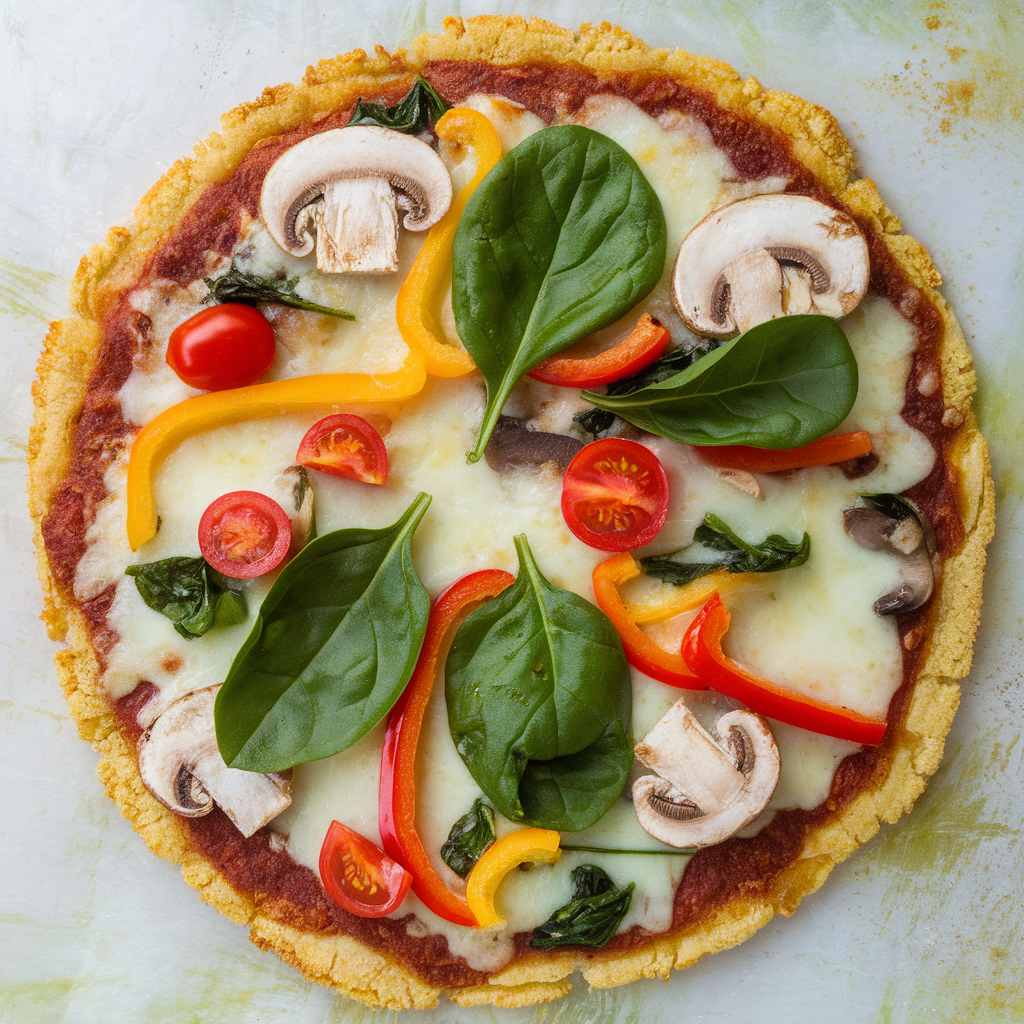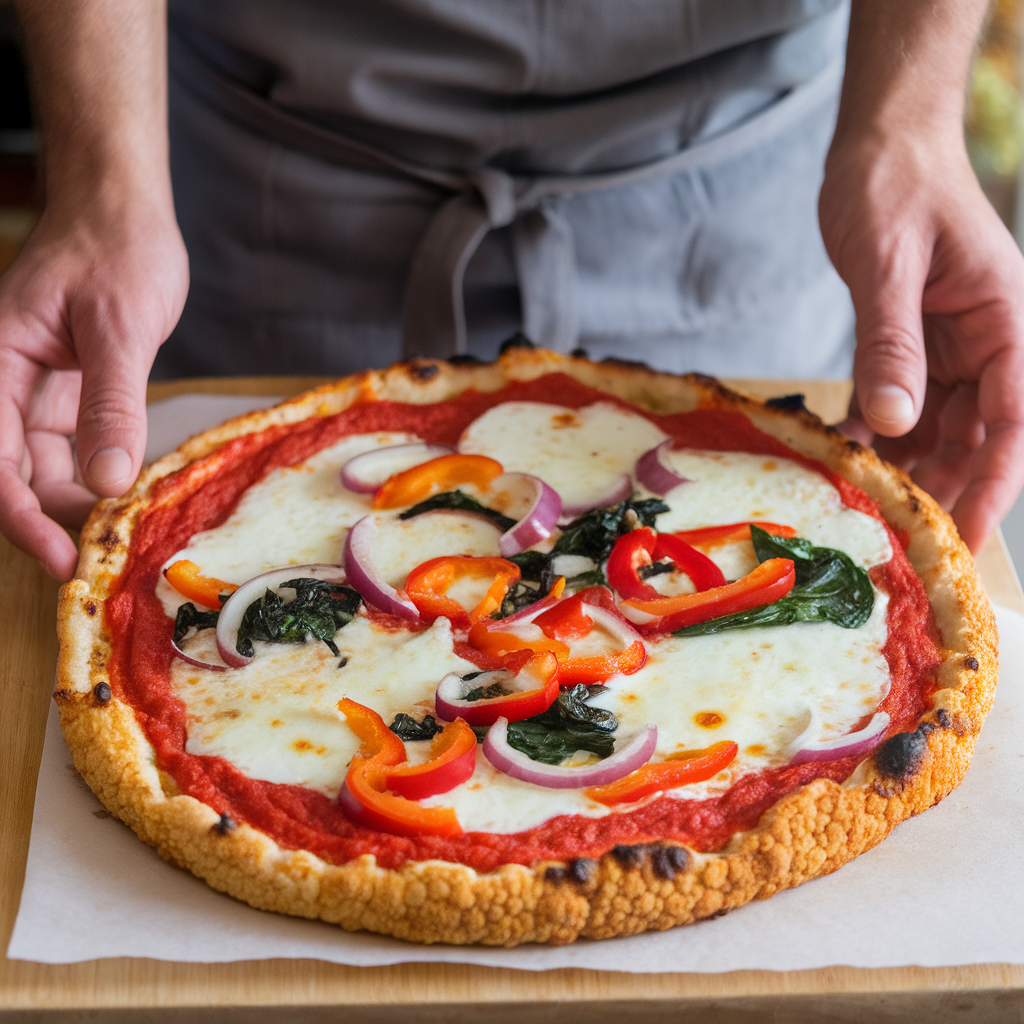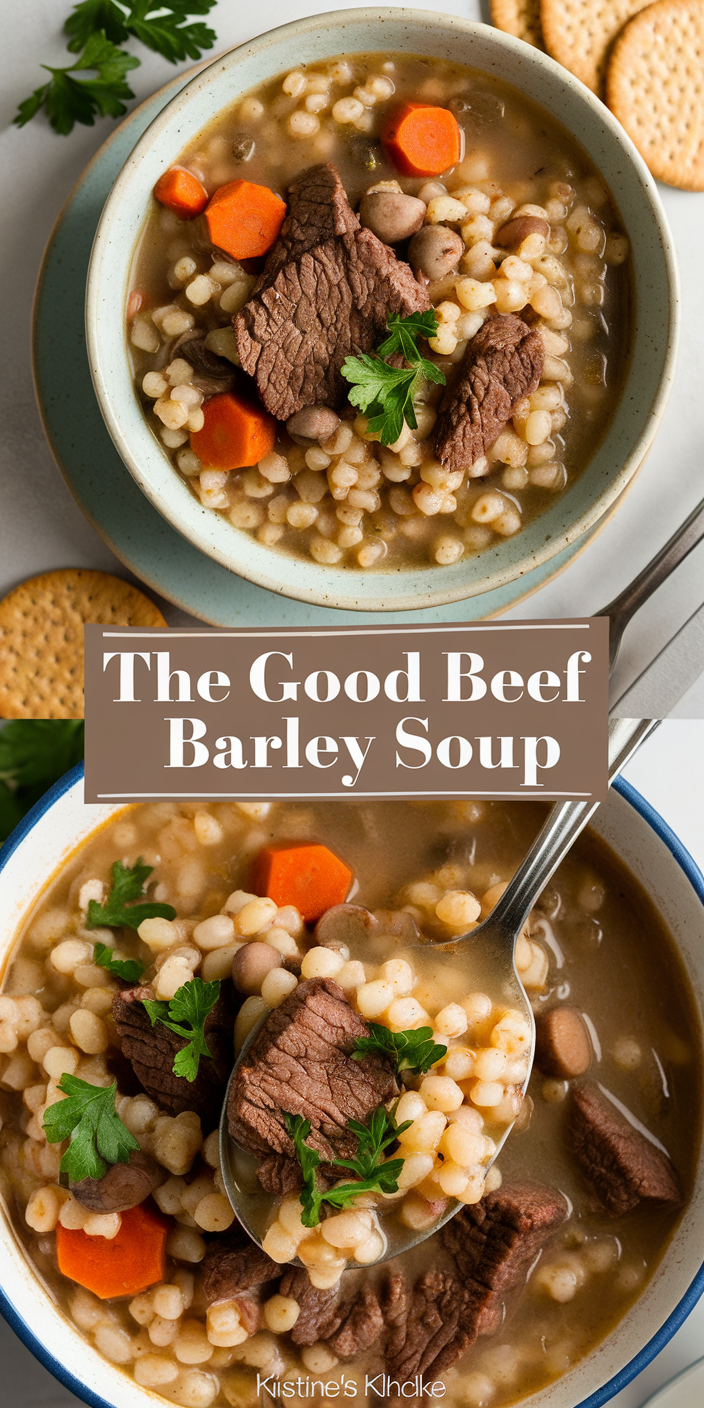Pizza is universally loved, but for those who follow low-carb, gluten-free, or ketogenic diets, traditional pizza crust can be a major obstacle. For pizza lovers who don’t want to sacrifice flavor while staying healthy, cauliflower pizza crust has emerged as the perfect alternative. An easy cauliflower pizza crust brings together the best of both worlds – the crispy, cheesy goodness of pizza crust without the heavy carbs or gluten. Whether you’re following a keto diet, looking for low carb low fat recipes, or simply need a gluten-free pizza crust, cauliflower crust pizza is an option that caters to your dietary needs while keeping the flavor intact.
In this article, we’ll explore how to make a perfect cauliflower pizza crust recipe, the benefits of keto pizza crusts, and why cauliflower pizza crust is a must-try for anyone seeking healthier alternatives without compromising on taste.
What is Cauliflower Crust Pizza?
Cauliflower crust pizza is a revolutionary concept in the world of healthy pizza alternatives. Instead of using traditional flour-based dough, cauliflower takes the lead as the primary ingredient in this crust. By finely chopping cauliflower, then combining it with ingredients like cheese, eggs, and spices, you create a dough-like mixture that can be shaped into a crust. Once baked, the cauliflower pizza crust becomes firm, crispy, and ready for your favorite toppings.
Cette cauliflower pizza crust recipe isn’t just about making pizza healthier; it also offers a delightful flavor that doesn’t feel like you’re eating a substitute. The use of cauliflower gives the crust a subtle flavor that blends well with any topping, from traditional tomato sauce and mozzarella to more inventive combinations like pesto or dairy-free cheese.
Why Is Cauliflower Crust So Popular?
The growing popularity of cauliflower pizza crust is due to its numerous health benefits and ability to cater to different dietary requirements. Whether you’re on a low-carb low-fat diet, a keto pizza crust enthusiast, or someone who avoids gluten for health reasons, this alternative has become a staple in many kitchens. Here’s why:
1. Low-Carb and Low-Calorie Option
Traditional pizza dough is made with flour, which is high in carbs. For those following a low-carb low-fat recipe, cauliflower is a great substitute. One slice of cauliflower pizza crust typically contains only 2 to 3 grams of net carbs, compared to over 30 grams per slice in traditional pizza crusts. This low-carb feature makes cauliflower crust an excellent choice for people on ketogenic or Atkins diets. Cauliflower itself is low in calories, which means you can indulge in a delicious pizza while staying within your calorie limit.

2. Gluten-Free Pizza Crust
If you’re sensitive to gluten or need to avoid it due to celiac disease, you’ll be happy to know that cauliflower crust is naturally gluten-free. Traditional pizza crusts made from wheat flour can cause digestive issues for those who can’t tolerate gluten. Cauliflower, however, is a safe and tasty alternative that allows gluten-intolerant individuals to enjoy their pizza without any concern.
3. Riche en Nutriments
Cauliflower is more than just a low-carb vegetable; it is also packed with vitamins and minerals. This versatile vegetable is rich in vitamin C, which boosts your immune system and promotes healthy skin. It’s also a great source of fiber, folate, and antioxidants, making it a powerful addition to any diet. Adding cauliflower to your pizza crust means you’re also adding a healthy dose of nutrients to your meal.
4. Keto-Friendly Crust
For those on the ketogenic diet, which focuses on high-fat, moderate-protein, and very low-carb foods, keto pizza crusts like cauliflower crust are a perfect choice. Traditional pizza crusts made from wheat flour would be a carb overload in the keto world, but cauliflower’s low-carb nature makes it an ideal alternative that won’t knock you out of ketosis. Plus, its texture and flavor still mimic that of a classic pizza crust, satisfying pizza cravings without breaking keto rules.
5. Easy to Make and Versatile
Making cauliflower pizza crust is easy, and it doesn’t require any special skills or tools. Whether you’re making your crust from scratch or using pre-packaged cauliflower rice, the steps are straightforward. Additionally, cauliflower pizza crust is incredibly versatile. You can experiment with different toppings, cheeses, and seasonings to create a pizza that fits your tastes and dietary needs.
How to Make Easy Cauliflower Pizza Crust
Faire easy cauliflower pizza crust at home is simple and requires only a few ingredients. The beauty of this recipe is that it is completely customizable, and you can adjust the seasonings and toppings according to your preferences. Let’s dive into how you can make your own gluten-free pizza crust that is both healthy and delicious.
Ingrédients:
- 1 medium cauliflower head (or 4 cups of cauliflower rice)
- 1 gros œuf
- 1 cup shredded mozzarella cheese
- 1/4 cup grated parmesan cheese
- 1/2 teaspoon dried oregano
- 1/4 cuillère à café de poudre d'ail
- Sel et poivre au goût
- Optional: 1/4 cup almond flour or coconut flour (to help firm up the crust)

Instructions:
1. Préchauffer le Four:
Start by preheating your oven to 400°F (200°C). Line a baking sheet with parchment paper or a silicone baking mat. This ensures that the crust doesn’t stick during baking.
2. Prepare the Cauliflower:
Wash the cauliflower thoroughly and remove the leaves and stem. Cut it into small florets. Use a food processor to pulse the cauliflower into fine rice-sized pieces. Alternatively, you can grate it using a box grater. You’ll need about 4 cups of finely chopped cauliflower for the crust.
3. Cook the Cauliflower:
Transfer the cauliflower rice to a microwave-safe bowl and microwave it for 4-5 minutes, or steam it for about 7 minutes until softened. Once cooked, allow it to cool for a few minutes.
4. Remove Excess Moisture:
Once the cauliflower has cooled, place it in a clean kitchen towel or cheesecloth and wring out any excess moisture. Removing moisture is crucial to achieving a crispy and firm crust, so be sure to squeeze out as much liquid as possible.
5. Prepare the Dough:
In a large mixing bowl, combine the cauliflower rice, shredded mozzarella cheese, parmesan cheese, egg, oregano, garlic powder, salt, and pepper. Mix well until all ingredients are evenly distributed. If you’d like to make the dough firmer, you can add almond flour or coconut flour at this stage. This helps bind the crust and adds a bit of texture.
6. Shape the Crust:
Transfer the dough to the prepared baking sheet. Using your hands, press the mixture into a round or rectangular shape about 1/4 inch thick. Press the edges slightly to form a crust-like border.
7. Bake the Crust:
Place the baking sheet in the preheated oven and bake the cauliflower crust for 15-20 minutes, or until the edges are golden brown and crispy. It should be firm to the touch and hold its shape when lifted.
8. Add Toppings:
Once the crust is done, remove it from the oven. Now comes the fun part! Add your favorite pizza toppings. You can stick to classic toppings like tomato sauce, mozzarella cheese, pepperoni, or veggies, or get creative with something more unique like pesto, goat cheese, and arugula.
9. Bake Again:
After adding the toppings, return the pizza to the oven and bake for an additional 5-7 minutes, or until the cheese is melted and bubbly.
10. Slice and Serve:
Remove the pizza from the oven and let it cool slightly. Slice it up, and your delicious, low-carb low-fat pizza is ready to be enjoyed!
Customizing Your Cauliflower Pizza Crust
One of the best aspects of cauliflower pizza crust is how customizable it is. Here are a few variations you can try to suit your taste preferences:
1. Cheesy Cauliflower Crust:
For a richer, cheesier crust, you can increase the amount of mozzarella or add other cheeses like cheddar or gouda. This will create a more indulgent and flavorful base.
2. Spicy Cauliflower Crust:
For those who like a bit of heat, you can add red pepper flakes or chili powder to the cauliflower dough. This will give your pizza a nice kick and enhance the flavor profile.
3. Herbed Cauliflower Crust:
You can elevate the flavor of your crust by adding fresh herbs like basil, rosemary, or thyme to the cauliflower mixture. The fragrant herbs will add a lovely aroma and enhance the overall pizza experience.

4. Meat Lovers Cauliflower Crust:
For a heartier crust, consider adding cooked ground beef, sausage, or crumbled bacon to the cauliflower dough. This will add extra protein and flavor, turning your cauliflower pizza into a filling meal.
5. Vegetarian Cauliflower Crust:
If you prefer to keep things light, you can add finely chopped vegetables such as spinach, bell peppers, onions, or zucchini directly into the cauliflower dough. This will add fiber and vitamins to your pizza.
Health Benefits of Cauliflower Crust Pizza
Cauliflower pizza crust isn’t just a healthier option; it’s packed with health benefits that make it even more appealing. Here are a few reasons why cauliflower crust pizza should be a regular in your meal plan:
1. Low-Carb and Keto-Friendly
For those on a keto diet, cauliflower pizza crust is a dream come true. With only 2 to 3 grams of net carbs per slice, it allows you to indulge in pizza without worrying about spiking your blood sugar. The low-carb nature of cauliflower makes it a perfect fit for those looking to maintain ketosis.
2. Rich in Fiber
Cauliflower is an excellent source of fiber, which is essential for healthy digestion and maintaining stable blood sugar levels. Fiber also promotes feelings of fullness, which can help you manage your weight more effectively.
3. Riche en Nutriments
In addition to being low in carbs, cauliflower is loaded with essential nutrients. It contains vitamin C, a powerful antioxidant that boosts immunity and promotes healthy skin. It’s also a good source of folate, which is essential for cell division and the production of DNA, as well as vitamin K, which plays a role in bone health.
4. Gluten-Free
For individuals with gluten intolerance or celiac disease, cauliflower pizza crust provides a safe and delicious alternative to traditional wheat-based pizza dough. This crust allows you to enjoy pizza without any gluten-related concerns.
5. Weight Management
Since cauliflower is low in calories and rich in nutrients, it’s a great food to incorporate into a weight management plan. The fiber in cauliflower also promotes fullness, helping you resist overeating.
Why Cauliflower Pizza Crust is a Must-Try
Whether you’re trying to cut back on carbs, avoid gluten, or simply want a healthier alternative to traditional pizza, cauliflower pizza crust is a must-try. This easy-to-make, nutrient-packed crust is a healthier option that doesn’t compromise on taste or texture. It’s the perfect solution for anyone looking to enjoy their pizza while sticking to their dietary goals.
With its low carb, low fat recipe, versatility in toppings, and health benefits, cauliflower crust pizza offers a way to enjoy your favorite dish without the guilt. Try it today, and let your taste buds experience the magic of this healthier pizza alternative!
Conclusion
Cauliflower pizza crust offers the best of both worlds – the delicious, satisfying taste of pizza combined with the health benefits of a low-carb low-fat alternative. Whether you follow a keto diet, need a gluten-free pizza crust, or just want a healthier option, this easy cauliflower pizza crust recipe has you covered. Try it with your favorite toppings and enjoy a pizza night that’s both delicious and good for you.


